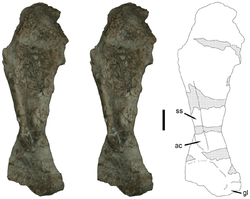Popo Agie Formation
| Popo Agie Formation Stratigraphic range: Late Triassic | |
|---|---|
| Type | Geological formation |
| Unit of | Chugwater Group |
| Overlies | Gartra Formation |
| Location | |
| Region | North America |
| Country | United States |
The Popo Agie Formation is a Triassic geologic formation that outcrops in western Wyoming, western Colorado, and Utah. It was deposited during the Late Triassic in fluvial (river) and lacustrine (lake) environments that existed across much of what is now the American southwest.[1] Fragmentary fossils of prehistoric reptiles and amphibians, including pseudosuchian reptiles and temnospondyl amphibians, have been discovered in the Popo Agie Formation. Dinosaur remains are also among the fossils that have been recovered from the formation, although none have yet been referred to a specific genus.[2]
Paleobiota
Color key
|
Notes Uncertain or tentative taxa are in small text; |
Amphibians
| Taxon | Member | Material | Notes | Images |
|---|---|---|---|---|
|
Apachesaurus sp. |
Complete skull |
A metoposaurid temnospondyl; specimen from the Popo Agie Formation was originally described as Anaschisma sp. and later Eupelor browni[3] |
||
|
Koskinonodon perfecta |
Complete skull |
A metoposaurid temnospondyl; specimen from the Popo Agie Formation was originally described as Borborophagus wyomingensis[3] |
||
|
Metoposauridae indet. |
Complete skull |
Specimen was originally described as Anaschisma browni[3] |
||
Reptiles
| Taxon | Member | Material | Notes | Images |
|---|---|---|---|---|
|
UW 11562, a partial skull and postcranial skeleton; UW 11563 through UW 11565, partial postcranial remains; both from Big Horn Mountains, Wyoming[4] |
||||
|
Hyperodapedon cf. H. sanjuanensis |
USNM 494329, a left maxilla and premaxilla from Willow Creek, Wyoming[5] |
|||
|
UR 358, a partial ilium from Lander, Wyoming;[6] UR 357, a partial skeleton including vertebrae, hips, and limb bones[7] |
A bipedal poposauroid first described from the Popo Agie Formation and known from more complete specimens from the Chinle Formation[8] |
| ||
Synapsids
| Taxon | Member | Material | Notes | Images |
|---|---|---|---|---|
|
FMNH UC 633, a partial left scapula, left humerus, and left pelvis from Lander, Wyoming |
One of only two dicynodonts known to have lived in the northern hemisphere during the Late Triassic, the other being Placerias from the Chinle Formation[9] |
| ||
See also
Footnotes
- ↑ High, L.R.; Hepp, D.M.; Clark, T.; Picard, M.D. (1969). "Stratigraphy of Popo Agie Formation (Late Triassic), Uinta Mountain Area, Utah and Colorado". Geologic Guidebook of the Uinta Mountains: Utah’s Maverick Range (Sixteenth Annual Field Conference ed.). Utah Geological Association. pp. 181–192.
- ↑ Weishampel, et al. (2004). "Dinosaur distribution." Pp. 517-607.
- 1 2 3 Sulej, T. (2002). "Species discrimination of the Late Triassic temnospondyl amphibian Metoposaurus diagnosticus" (PDF). Acta Palaeontologica Polonica. 47 (3): 535–546.
- ↑ Dawley, R.M.; Zawiskie, J.M.; Cosgriff, J.W. (1979). "A rauisuchid thecodont from the Upper Triassic Popo Agie Formation of Wyoming". Journal of Paleontology. 53 (6): 1428–1431.
- ↑ Lucas, S.G.; Heckert, A.B.; Hotton, N.III. (2002). "The rhynchosaur Hyperodapedon from the Upper Triassic of Wyoming and its global biochronological significance" (PDF). In Heckert, A.B.; and Lucas, S.G. (eds.). Upper Triassic Stratigraphy and Paleontology. 21. New Mexico Museum of Natural History and Science Bulletin. pp. 149–156.
- ↑ Lees, J.H. (1907). "The skull of Paleorhinus, a Wyoming phytosaur". The Journal of Geology. 15 (2): 121–151. doi:10.1086/621382. JSTOR 30056366.
- ↑ Mehl, M.G. (1915). "Poposaurus gracilis, a new reptile from the Triassic of Wyoming". The Journal of Geology. 23 (6): 516–522. doi:10.1086/622268. JSTOR view/30067173.
- ↑ Gauthier, J.A.; Nesbitt, S.J.; Schachner, E.R.; Bever, G.S.; Joyce, W.G. (2011). "The bipedal stem crocodilian Poposaurus gracilis: inferring function in fossils and innovation in archosaur locomotion" (PDF). Bulletin of the Peabody Museum of Natural History. 52 (1): 107–126. doi:10.3374/014.052.0102.
- ↑ Kammerer, C. F.; Fröbisch, J. R.; Angielczyk, K. D. (2013). Farke, Andrew A, ed. "On the Validity and Phylogenetic Position of Eubrachiosaurus browni, a Kannemeyeriiform Dicynodont (Anomodontia) from Triassic North America". PLoS ONE. 8 (5): e64203. doi:10.1371/journal.pone.0064203.
References
- Weishampel, David B.; Dodson, Peter; and Osmólska, Halszka (eds.): The Dinosauria, 2nd, Berkeley: University of California Press. 861 pp. ISBN 0-520-24209-2.

